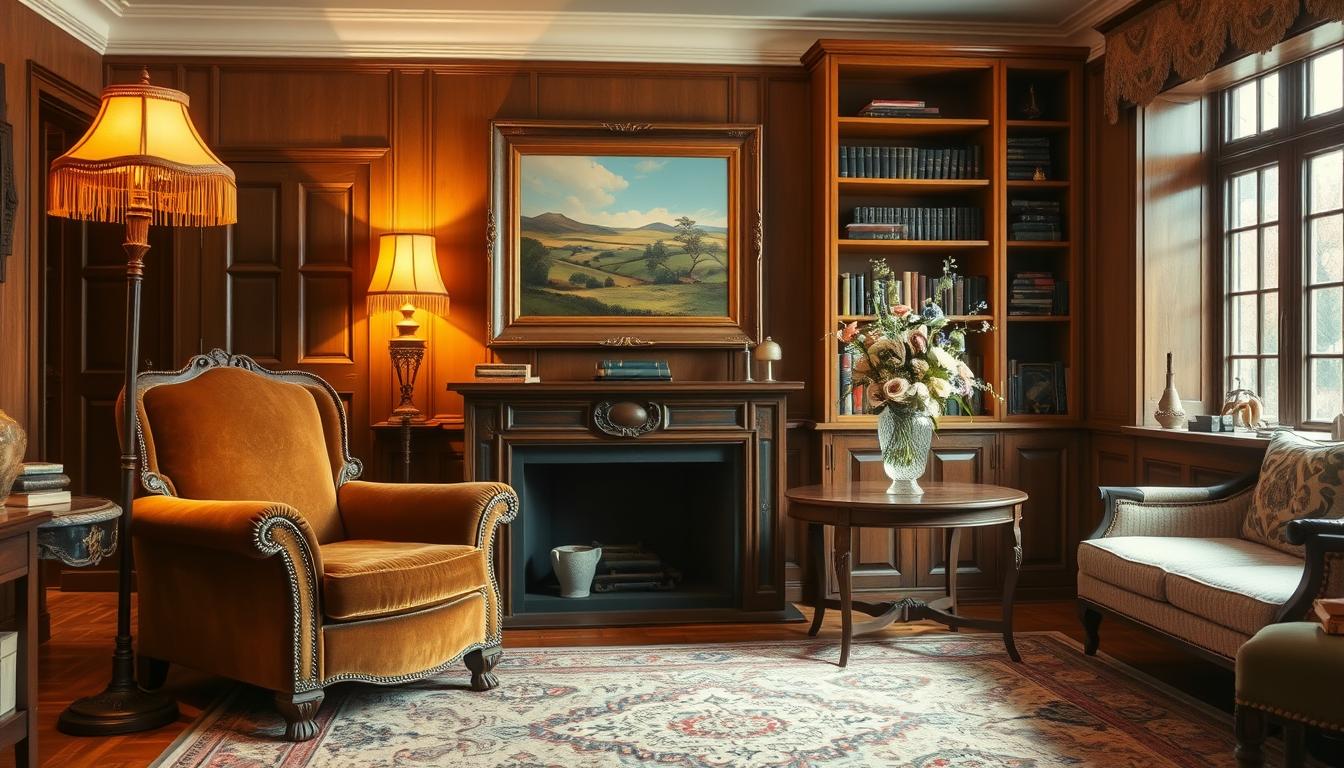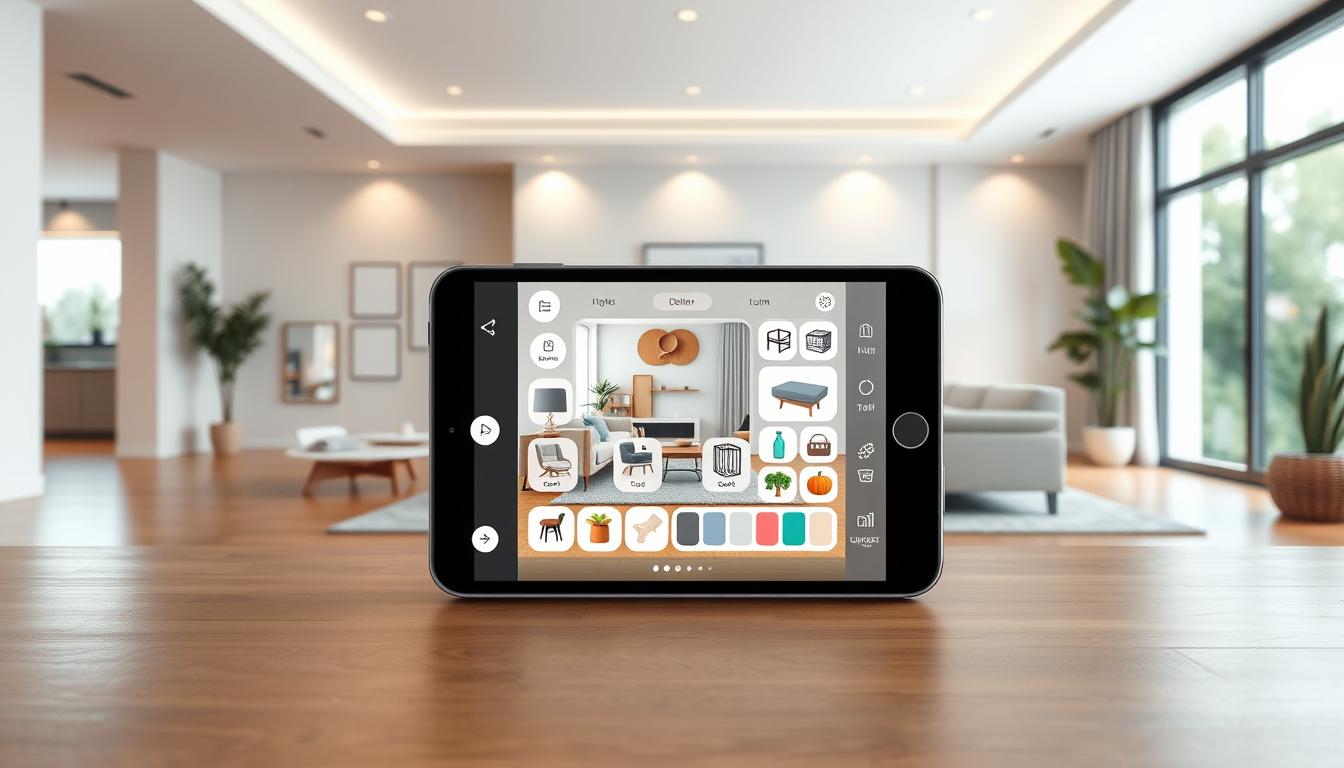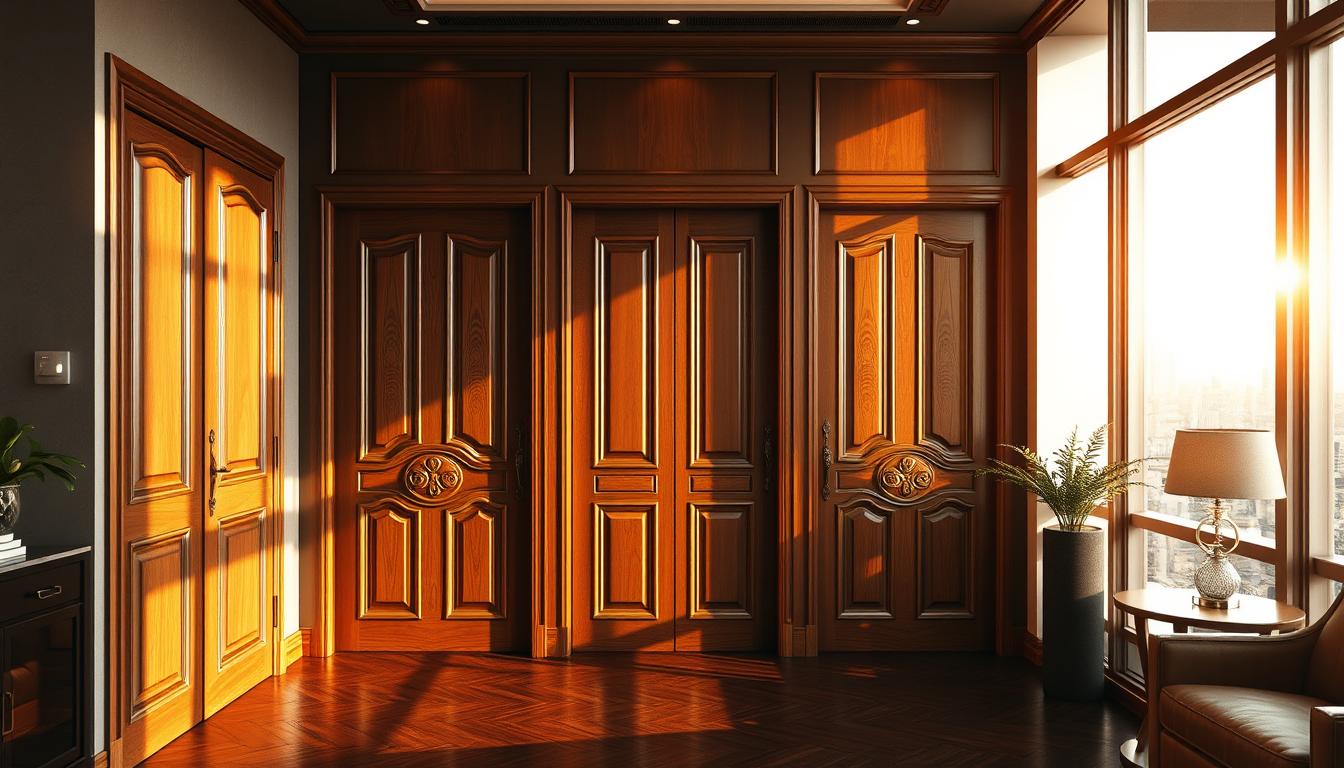The Roaring Twenties may be over, but the glamour of the 1930s home interiors still fascinates us. This era’s style is a mix of vintage home decor and the luxury of art deco design. It’s a blend of elegance and a hint of the past.
We’ll show you how to bring this timeless style into your home. We’ll cover the essential design elements, picking the right furniture, and choosing accessories. By mixing old with new, you can add a piece of history to your modern space.
Key Takeaways
- Understand the key elements of 1930s design
- Learn how to select vintage furniture and accessories
- Discover tips on balancing vintage and modern elements
- Explore the importance of authenticity in achieving a genuine look
- Find out how to incorporate art deco design into your decor
Introduction to 1930s Home Interior Design
The 1930s was a key time for interior design. It saw the rise of Art Deco and new materials. This era changed how homes were designed and furnished, showing the cultural shifts of the time.
Overview of the 1930s Style
The 1930s style is all about luxury and glamour, thanks to Art Deco. It’s known for bold patterns, metallic touches, and rich materials. To get a 1930s look, you need to use these elements in a way that feels right for the era.
Importance of Authenticity
Being true to the 1930s is key when decorating a home from that era. This means choosing furniture and decor that’s typical of the time. It also means focusing on the small details that make a space feel vintage.
Using real or period-specific materials and craftsmanship adds to the authenticity. For example, restoring old furniture or using traditional building methods can make your space feel richer and more characterful.
Key Elements of 1930s Design
Several elements are key to 1930s interior design. These include bold colors and patterns, luxurious materials, and eye-catching lighting. Knowing these elements is important for creating a genuine 1930s home interior.
| Design Element | Description | Example |
|---|---|---|
| Bold Geometric Patterns | Use of geometric shapes in wallpaper, rugs, and textiles. | Chevron patterns on wallpapers or zigzag motifs on rugs. |
| Metallic Accents | Incorporation of metallic materials like chrome, brass, and silver. | Chrome-finished lighting fixtures or brass hardware on furniture. |
| Luxurious Materials | Use of high-quality materials such as velvet, marble, and exotic woods. | Velvet upholstered furniture or marble-topped side tables. |
By understanding and using these elements, you can make a 1930s home interior that’s both real and beautiful.
Color Palette Trends of the 1930s
The 1930s were known for their bold and soft colors. These hues still inspire fans of classic home decor today. The decade saw a big change in interior design, with colors being key to the look of homes.
Popular Colors and Shades
The 1930s brought unique color trends that still shape interior design. Some standout colors from the era include:
- Bold primaries such as red, blue, and yellow
- Soft pastels like pale pink, baby blue, and mint green
- Earth tones including terracotta, sienna, and umber
- Rich jewel tones like emerald green and sapphire blue
These colors were mixed in different ways to make homes welcoming and unique.
Techniques for Using Color
To use the 1930s color palette in your home, try these methods:
- Make bold colors stand out on accent walls or furniture.
- Pair bold colors with neutral shades to keep the room balanced.
- Add soft pastels for elegance and class.
- Use different textures and patterns to add depth and interest.
These techniques help create a nostalgic feel that honors the 1930s style.
Examples of Color Combinations
Some classic color pairs from the 1930s are:
- Navy blue and cream
- Forest green and gold
- Soft peach and pale gray
- Rich red and dark wood tones
These combos can be updated for today by mixing them with modern furniture and decor. This keeps the vintage home decor feel alive.
Furniture Characteristics in 1930s Homes
Furniture was key in 1930s homes, mixing modern and traditional. The 1930s brought new materials and ways to make furniture.
Streamlined Styles and Modernist Influences
The 1930s saw a big change in furniture design. Modernist and Art Deco styles became popular. Modernist furniture was simple and clean. Art Deco added luxury with bold colors and patterns.
Retro interior design became trendy. Furniture started to look sleek and aerodynamic. New materials like tubular steel helped shape this look.
Materials and Craftsmanship
Exotic woods like ebony became common in furniture. New tech like bent plywood made pieces strong and new.
More people could buy good furniture thanks to new ways of making it. Yet, the old ways of craftsmanship were still prized. Many pieces were made with care for details.
“The modern furniture of the 1930s was characterized by a sense of freedom and experimentation, as designers pushed the boundaries of form and function.”
Iconic Furniture Brands
Some brands became famous in the 1930s for their quality and design. Eames and Le Corbusier led in modernist design. They made pieces that were both useful and beautiful.
When picking furniture for a 1930s look, look for modernism, luxury, and new materials. Choose vintage or new pieces that capture the 1930s spirit.
Wall Treatments: Paint and Wallpaper
In the 1930s, decorating walls became an art form. Homeowners used wallpaper and paint to make their interiors stand out. The right choice could add depth, texture, and personality to a room.
Popular Wallpaper Patterns
Wallpaper was key in 1930s homes, with many patterns to choose from. Geometric patterns like chevrons and hexagons were big hits. Floral motifs also added elegance to rooms.
Some top wallpaper designs from back then included:
- Stripes and geometrics
- Floral patterns
- Abstract designs
These designs showed off the era’s style and set the mood of a room.
Choosing the Right Paint Colors
Paint was also important in 1930s decor, with a focus on deep, muted colors. Think about the room’s use and the colors of furniture and fixtures. For example, soft pastels were great for bedrooms, while bold, rich colors worked well in living areas.
“The choice of wall color can dramatically affect the mood of a room, making it feel larger, cozier, or more vibrant.”
Techniques for Applying Wall Treatments
Applying wall treatments in the 1930s involved creative methods like stenciling and adding texture. Stencils helped create detailed designs, adding a personal touch. Texture was also key, with ragging and sponging used to make unique effects.
To get a 1930s look, try these techniques with your wallpaper or paint. The right method can make your space feel classic home decor that’s both timeless and welcoming.
Flooring Choices Popular in the 1930s
In the 1930s, people had many flooring options. Each had its own look and feel. Flooring was key to a home’s style.
Popular Flooring Materials
The 1930s favored certain flooring materials. They were picked for their looks, durability, and use. Here are some favorites:
- Hardwood flooring, loved for its warmth and classic look.
- Linoleum, a practical choice with many patterns and colors.
- Cork flooring, known for its soft feel and natural warmth.
| Material | Characteristics | Popularity in 1930s |
|---|---|---|
| Hardwood | Durable, warm, and classic | High |
| Linoleum | Practical, versatile, and affordable | Very High |
| Cork | Comfortable, insulating, and eco-friendly | Moderate |
Maintaining Vintage Flooring
Keeping vintage flooring in good shape is important. It helps it last longer. Cleaning, refinishing, and fixing small damages are key.
Tips for Maintenance:
- Regularly sweep and mop to avoid dirt.
- Choose the right cleaning products for your floor.
- Get professional help for refinishing hardwood.
The Role of Area Rugs
Area rugs were big in 1930s homes. They added warmth and defined areas. They also brought in new textures and designs.
Knowing about flooring and area rugs helps bring the 1930s vibe to your home.
Lighting Design in 1930s Interiors
Lighting was key in 1930s interiors. The right light fixture could make a room feel special. It added sophistication and warmth.
Iconic Lighting Fixtures
The 1930s saw big changes in lighting. New tech and Art Deco designs led to iconic pieces. These included:
- Sconces with geometric patterns and metallic finishes
- Chandeliers with detailed designs and luxury materials
- Table lamps with unique shapes and ornate details
These lights did more than just illuminate. They also added to the room’s look.
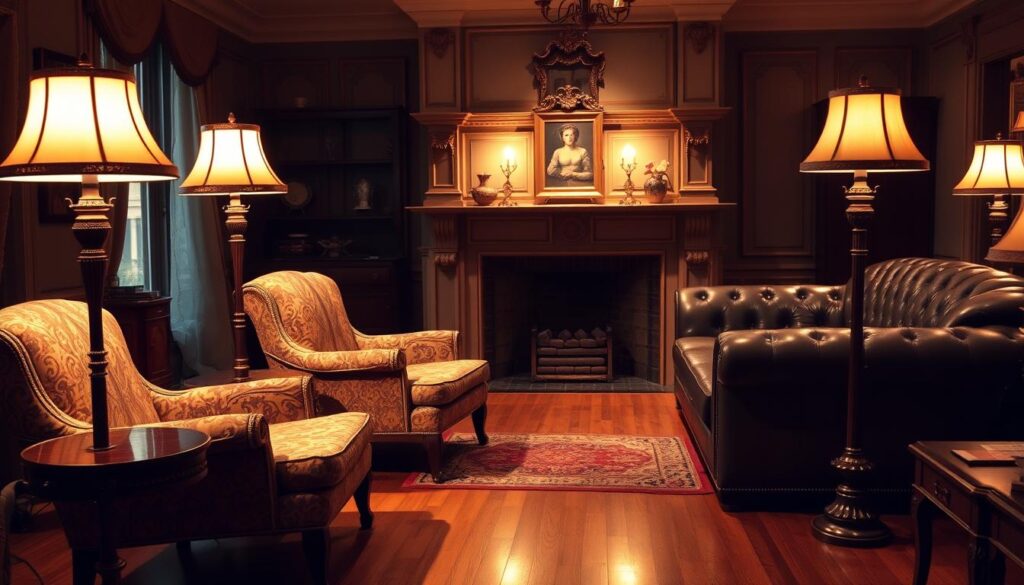
Layering Light for Ambiance
Layering light was crucial in 1930s design. Mixing light sources created a rich atmosphere. This mix included overhead lights, table lamps, and floor lamps.
To layer light effectively:
- Begin with a main light source, like a chandelier or ceiling fixture.
- Add secondary lights, such as table lamps or sconces, for more light.
- Use accent lighting to highlight special features or decor.
Modern Adaptations of Vintage Lighting
Keeping vintage charm in lighting is great, but modern updates are useful too. Today, many vintage-style lights use LED tech. This makes them energy-efficient without losing their classic look.
When adding modern touches, think about these tips:
- Find LED-compatible lights that still look vintage.
- Choose materials and finishes that match the old designs but are durable today.
- Blend vintage style with modern needs for a unique space.
Accessories and Décor Items
Accessories and décor items were key in 1930s homes, showing the era’s culture and social shifts. They added personality and showed what homeowners liked.
Decorative Art from the Era
The 1930s brought decorative art that was both useful and beautiful. Famous designers made pieces that were typical of the 1930s style. They used popular motifs and materials of the time.
Decorative art from then includes sculptures, vases, and wall hangings with art deco flair. These items had geometric shapes, metallics, and bright colors. They brought glamour to historic home interiors.
The Role of Textiles in Decorating
Textiles were big in 1930s decorating, with vintage fabrics and patterns everywhere. Homes used everything from fancy silks and velvets to practical cottons and linens. This variety helped create cozy and inviting spaces.
Textiles weren’t just for furniture and curtains; rugs, throw pillows, and wall hangings also added texture and warmth. They helped make the spaces feel like they belonged to another time, adding to the nostalgia home decor vibe.
Tips for Choosing Authentic Accessories
To get a true 1930s look, pick accessories that match the era’s style and spirit. Here are some tips:
- Find vintage or replica items that are true to the 1930s, like art deco designs.
- Choose pieces made with materials and craftsmanship from back then, showing quality.
- Feel free to mix different styles and periods, as people did in 1930s homes.
By picking accessories and décor that are genuine to the era, you can make a space that’s both nostalgic and chic. It will capture the essence of 1930s style furniture and decor.
Kitchen Design and Features
The 1930s brought big changes to kitchen design. New tech and lifestyle shifts led to modern appliances and layouts. These changes made kitchens more efficient and stylish.
Layouts Common in 1930s Kitchens
Kitchens from the 1930s often had galley and U-shaped designs. These layouts saved space and improved workflow. They were perfect for smaller homes.
The galley layout had parallel counters for a smooth flow. The U-shaped design offered lots of counter space and storage, all in a compact form.
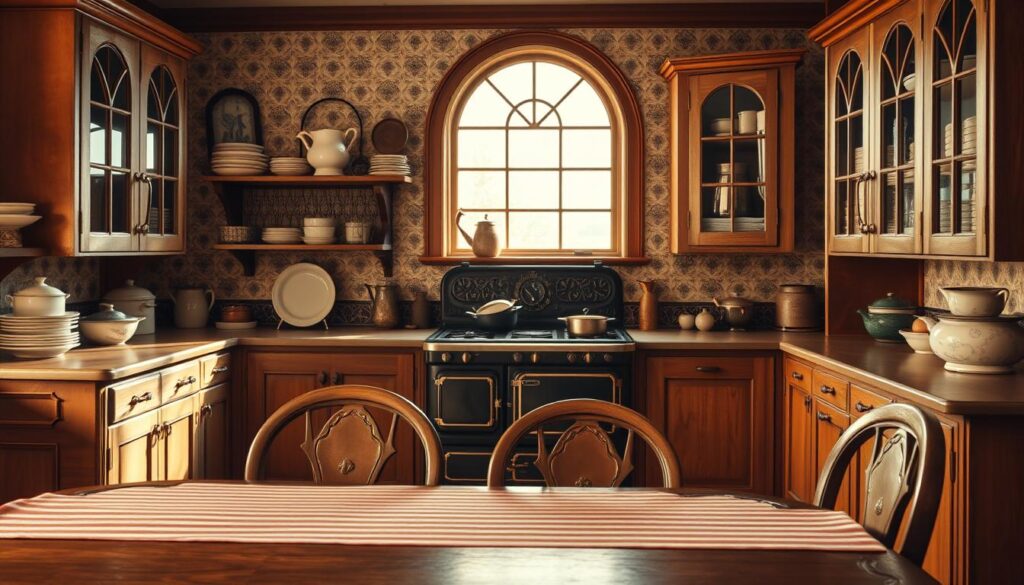
Popular Appliances and Fixtures
The 1930s saw the rise of electric refrigerators, replacing iceboxes. Enamel sinks became common for their durability and cleanliness. Early electric stoves and built-in cabinets also made their mark.
| Appliance/Fixture | Description | Impact on Kitchen Design |
|---|---|---|
| Early Electric Refrigerators | Replaced iceboxes, offering better food preservation | Changed storage needs and kitchen layouts |
| Enamel Sinks | Durable, easy to clean, and aesthetically pleasing | Enhanced kitchen hygiene and visual appeal |
| Built-in Cabinetry | Provided storage and contributed to a streamlined look | Maximized space and improved kitchen organization |
Storage Solutions and Organization
Storage was key in 1930s kitchen design. Built-in cabinets and pantries kept kitchens tidy. These solutions offered plenty of space for essentials and added to the kitchen’s look.
To get a true retro vibe, mix vintage touches with modern needs. Knowing about 1930s layouts, appliances, and storage helps create kitchens that are both nostalgic and useful.
Final Thoughts on 1930s Home Interiors
Creating a 1930s home interior is like stepping back in time. It’s all about embracing the art deco design and nostalgia that defined that era. We’ve seen how 1930s homes are known for their bold colors, geometric patterns, and rich materials.
Key Design Elements
The heart of 1930s style is its unique furniture, wall treatments, and flooring. Iconic lighting, decorative art, and textiles all play a part in the look.
Blending Vintage with Modern
Mixing vintage and modern elements is key to a welcoming space. Adding 1930s-inspired pieces can bring a nostalgic feel to your home.
Finding Inspiration
Start your 1930s home interior project by exploring the era’s design. Try out bold colors, luxurious materials, and eye-catching pieces to reflect your style.
Embracing 1930s home interiors lets you create a space that’s both old and new. It’s perfect for those who love art deco and nostalgia in their decor.

